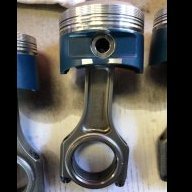Announcements
-
Similar Content
-
Latest Posts
-
Finally replaced the previous temporary mesh indicator surrounds (temporary was the last 10+ years 😂) with a 3D printed GTR style version for the front indicators. I think it looks a lot nicer than the old setup and at least the indicators now point in the correct direction rather than angled off. Needed a little bit of tweaking to deal with the intercooler piping but got there in the end. Old and new photos below.
-
By joshuaho96 · Posted
It's weird to me that you say this because I'm pretty sure locals with relatively standard standalone tunes (boost/barometric compensated alpha-N) still have driveability issues when they pop intercooler hoses. Maybe with enough data I can just train some kind of model that spits out an expected grams/cyl given every sensor input except MAF like what FCA did with their Pentastar 3.6 ECU logic. Basically stock everything. The main motivation honestly is to have a sensor that can be a decent baseline source of truth. In scenarios you're describing obviously it won't work every time but it seems to me the number of corner cases that exist in MAF load is maybe not as severe and difficult to manage vs ITB alpha-N with some MAP/barometric compensation. -
What are your plans for your blow off valves? Purely plumb back? How soft will the spring in them be? AFM can be tricky to get super smooth and nice, especially depending on the rest of the system, and then can be very easily upset if something slightly changes. IE, even if you run recirc blow off valves, you could still see issues getting it to behave at certain load points as turbos might start to spool, but you release the throttle but it's not enough pressure to crack the bov open to recirc, and you can end up with reversion which can cause double metering, and hence dumping of fuel into the system, and stalling the engine. If you're going to run a map sensor for closed loop boost control from the ECU, what makes you want to keep the AFM?
-
By Dose Pipe Sutututu · Posted
It's not bad, it's just not flexible. And say if you have any leaks between the MAF and plenum, well then your load axis goes out the window. Here's a real world scenario, I blew off an intercooler hose last track day, as the clamp decided to Bluetooth itself somewhere. Still continued to do 2 laps and drive it to the pub for a couple of beers then home. Good luck doing that with a MAF setup -
By joshuaho96 · Posted
Is MAF load really that bad? I'm not trying to do big power, my only real desire is VCAM and flex fuel support so I'm not terrified of blowing my engine apart from CA's appalling 95 RON "premium" fuel. Stuff like playing with closed loop boost control and really dialing in my transient fueling and ignition are frankly just to prove to myself I remembered something from uni.
-






Recommended Posts
Create an account or sign in to comment
You need to be a member in order to leave a comment
Create an account
Sign up for a new account in our community. It's easy!
Register a new accountSign in
Already have an account? Sign in here.
Sign In Now